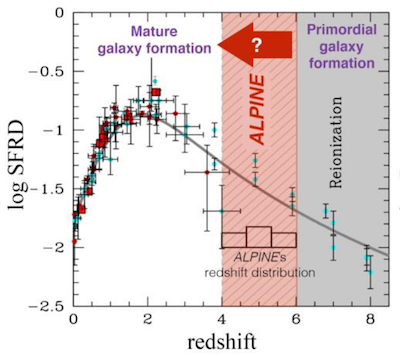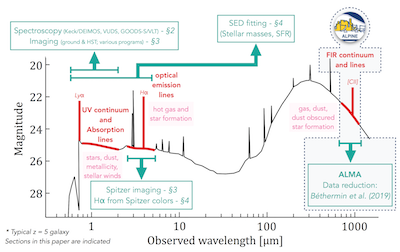
Overview
ALPINE is a 70h cycle 5 ALMA program (2017.1.00428.L) to study the gas and dust properties of young galaxies during the early growth phase at redshifts z = 4-6 (when the Universe was less than 1.5 billion years old). ALPINE observes in total 122 main-sequence galaxies with spectroscopic redshifts between 4.4 to 5.9 in COSMOS (108) and the GOODS-S/ECDFS (14) at a rest-frame wavelength of 158 micro-meter and measures their singly ionized Carbon emission (C+) as well as their far-infrared (FIR) continuum. The chosen galaxies are representative of the Universe at these times and therefore ALPINE provides a representative picture of their physical properties.
Also, check out our ALPINE outreach webpage with more information about the survey.
Science Goals
ALPINE builds the first multi-wavelength survey at these redshifts with data from the ultra-violet to the far-infrared. Some of the main science questions addressed by ALPINE are the following:
- How does the cosmic star-formation rate (SFR) density change into the early Universe? - Far-infrared continuum measurements from ALPINE reveal dust-obscured star formation in these galaxies that allow the study of the true SFR density in the Universe. Through serendipitous detections (galaxies only detected in the far-infrared), ALPINE also provides constraints on dust-obscured galaxies (so called "optically dark" galaxies).
- What are the mechanisms that fuel the initial growth of galaxies? - ALPINE measures gas properties and gas fractions of galaxies in the early Universe using C+ kinematics and far-infrared continuum. With this we can, for example, study the efficiency at which these galaxies are forming stars.
- What are the interstellar medium properties of galaxies in the early Universe and how do they compare to the present day galaxies? - ALPINE constrains the gas and dust properties of these galaxies and provides insight into the characteristics of their interstellar medium (such as winds, outflows, gas kinematics, radiation and temperature properties).
In addition to this, ALPINE provides a lasting legacy in the data-rich GOODS-S/ECDFS and COSMOS areas. These data pave the way for detailed follow-up observations, e.g., with ALMA at higher spatial resolution, and provide a reference sample for studies with future facilities like JWST.
My Contribution
I am the North America Science and Data lead of ALPINE. I coordinated the writing of the proposal and wrote substantial parts of it. Furthermore, I designed the observations and assembled the sample. My work currently concentrates on the creation of a database with imaging and spectroscopy for the ALPINE galaxies, specifically from the Spitzer Space Telescope imaging and our unique Keck spectroscopy. The ancillary data accompanying ALPINE are presented in Faisst et al. (2020). I am also the outreach coordinator for ALPINE.
The Principle Investigator Team
- Olivier LeFevre (LAM): Overall project coordination
- Andreas Faisst (Caltech/IPAC): North America Science/Data lead and outreach coordinator
- Matthieu Bethermin (LAM): ALMA data reduction lead
- Peter Capak (Caltech/IPAC)
- Paolo Cassata (IFA Chile)
- Daniel Schaerer (Geneva Observatory)
- John Silverman (IPMU Tokyo)
- Lin Yan (Caltech)
- + more than 40 co-Investigators
Data Products
The ALMA data products are available at https://cesam.lam.fr/a2c2s/. The ancillary data catalogs are available here. If you are using any data products or refer to ALPINE, please cite the following three papers:
- Survey overview paper (LeFèvre et al. 2020)
- ALMA data reduction paper (Béthermin et al. 2020)
- ALPINE ancillary data paper (Faisst et al. 2020)
More on this topic:
Faisst et al. (2019a)
Faisst et al. (2020)
LeFèvre et al. (2020)
Béthermin et al. (2020)
ALPINE studies in detail the transition phase between primordial and mature galaxy formation at redshifts 4 < z < 6 (less than 1.5 billion years after the Big Bang). (Figure from Faisst et al. 2019a)
ALPINE is not only the largest targeted ALMA survey at these redshifts, it also represents the first (and largest) multi-wavelength survey. It combines a wealth of ancillary data from high-resolution spectroscopy to deep ground- and space-based imaging. (Figure from Faisst et al. 2020)

